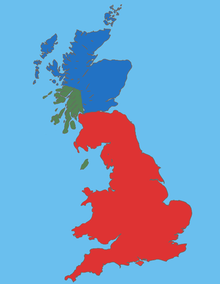
Back بريطونيون كلتيون Arabic Britlər Azerbaijani Брыты Byelorussian Брити Bulgarian Brezhoned Breton Britans Catalan Britonové Czech Brythoniaid Welsh Britere Danish Britonen German
This article needs additional citations for verification. (October 2021) |

The Britons (*Pritanī, Latin: Britanni, Welsh: Brythoniaid), also known as Celtic Britons[1] or Ancient Britons, were the indigenous Celtic people[2] who inhabited Great Britain from at least the British Iron Age until the High Middle Ages, at which point they diverged into the Welsh, Cornish, and Bretons (among others).[2] They spoke Common Brittonic, the ancestor of the modern Brittonic languages.[2]
The earliest written evidence for the Britons is from Greco-Roman writers and dates to the Iron Age.[2] Ancient Britain was made up of many tribes and kingdoms, associated with various hillforts. The Britons followed an Ancient Celtic religion overseen by druids. Some of the southern tribes had strong links with mainland Europe, especially Gaul and Belgica, and minted their own coins. The Roman Empire conquered most of Britain in the 1st century AD, creating the province of Britannia. The Romans invaded northern Britain, but the Britons and Caledonians in the north remained unconquered and Hadrian's Wall became the edge of the empire. A Romano-British culture emerged, mainly in the southeast, and British Latin coexisted with Brittonic.[3] It is unclear what relationship the Britons had with the Picts, who lived outside of the empire in northern Britain, however, most scholars today accept the fact that the Pictish language was closely related to Common Brittonic.[4]
Following the end of Roman rule in Britain during the 5th century, Anglo-Saxon settlement of eastern and southern Britain began. The culture and language of the Britons fragmented, and much of their territory gradually became Anglo-Saxon, while the north became subject to a similar settlement by Gaelic-speaking tribes from Ireland. The extent to which this cultural change was accompanied by wholesale population changes is still debated. During this time, Britons migrated to mainland Europe and established significant colonies in Brittany (now part of France), the Channel Islands,[5] and Britonia (now part of Galicia, Spain).[2] By the 11th century, Brittonic-speaking populations had split into distinct groups: the Welsh in Wales, the Cornish in Cornwall, the Bretons in Brittany, the Cumbrians of the Hen Ogledd ("Old North") in southern Scotland and northern England, and the remnants of the Pictish people in northern Scotland.[6] Common Brittonic developed into the distinct Brittonic languages: Welsh, Cumbric, Cornish and Breton.[2]


- ^ Graham Webster. (1996). "The Celtic Britons under Rome". In Green, Miranda (ed.). The Celtic World. Routledge. p. 623.
- ^ a b c d e f Koch, John (2006). Celtic Culture: A Historical Encyclopedia. ABC-CLIO. pp. 291–292.
- ^ Sawyer, P.H. (1998). From Roman Britain to Norman England. Routledge. pp. 69–74. ISBN 0415178940.
- ^ Forsyth, p. 9.
- ^ "The Germanic invasions of Britain". www.uni-due.de.
- ^ Scottish Archaeological Research Framework (ScARF), Highland Framework, Early Medieval (accessed May 2022).